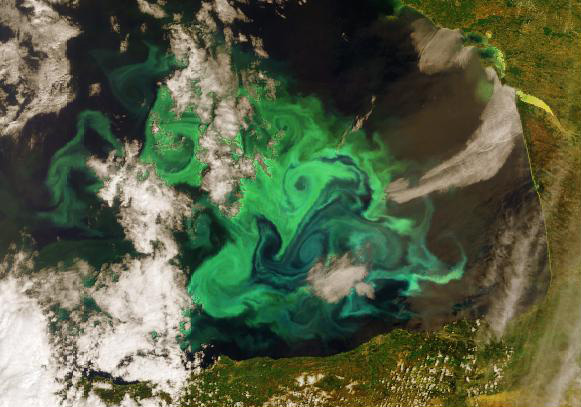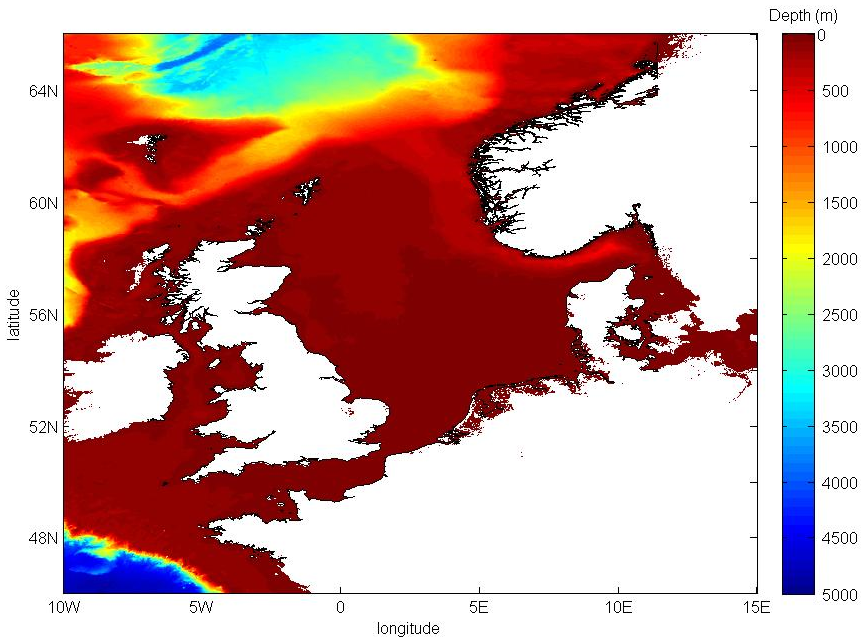Controlling Harmful Algal Blooms

The term "harmful algal bloom (HABs)" generally describes a rapid and significant increase in the concentration of algae/biomass within lakes or the ocean. They develop in response to an increase in the nutrient supply to a specific region, with anthropogenic activities being one of the main nutrient sources that trigger HABs [1-5]. Even though not all HABs are toxic, i.e. caused by algae that produce poisonous chemicals, they can have a detrimental effect on the marine ecosystem due to their impact on ocean oxygenation and the marine food web [5].
The increase in biomass during the blooms causes an increase in the concentration of chlorophyll, which makes HABs potentially detectable for satellites carrying spectrometers covering specific spectral bands. Probably the most commonly known type of HABs are the so called "red tides", which are produced by algae species that cause changes in water colour, which lie within the visible spectrum and are thus detectable by the human eye.
The frequency, spatial distribution and magnitude of HABs have increased significantly over the past decades. This development is most likely linked to global climate change and anthropogenically caused eutrophication [6-12]. With possible negative implications for fisheries and ultimately human health it is highly important to recognise the development of algae blooms at an early stage of their evolution and develop ways to defer possible harm for fisheries and humans.
The Project
This project investigates pathways to protect agriculture (fisheries, oyster farms etc.) from HABs. This will be achieved through the following three steps: 1.Collect past and newly derived satellite observations of algal blooms from e.g. ESA's ENVISAT, Sentinel-3 or NASA's SeaWiFS.
- Use those to assess the performance of a regional ocean model (ROMS) in regards to its ability to represent the evolution of those blooms starting from different blooming stages.
- Develop techniques to defer ocean currents and assess the (potentially unintentional) environmental impact of those techniques on the marine system in general.
The project will make use of Earth Observation (EO) data from ocean remote sensing instruments, i.e. spectrometers, on board of several EO satellite missions, including ESA's ENVISAT (2002-2012) and Sentinel-3 (planned launch
- missions. Together with other coinciding EO data, such as surface wind fields and sea surface temperatures, the collected ocean colour measurements of HAB events will be used to force a state-of-the-art regional ocean model.
The model used in this project is the Regional Ocean Modelling System (ROMS). It is a widely used tool within the scientific community that allows the numerical representation of oceanographic processes on a regional scale and covers a diverse range of applications (ROMS webpage).
In this project ROMS will be applied to a variety of geographical locations to predict the spread of HABs and assess the possibility to artificially steer and/or disperse HABs to prevent harm to local economies and human health.

References
- Shumway, S. E. (1990). A review of the effects of algal blooms on shellfish and aquaculture. Journal of the World Aquaculture Society, 21(2), 65-104.
- Burkholder, J. M. (1998). Implications of harmful microalgae and heterotrophic dinoflagellates in management of sustainable marine fisheries. Ecological applications, 8(sp1), S37-S62.
- Tang, D. L., Kawamura, H., Doan‐Nhu, H., and Takahashi, W. (2004). Remote sensing oceanography of a harmful algal bloom off the coast of southeastern Vietnam. Journal of Geophysical Research: Oceans (1978–2012), 109(C3).
- Ahn, Y. H., and Shanmugam, P. (2006). Detecting the red tide algal blooms from satellite ocean color observations in optically complex Northeast-Asia Coastal waters. Remote Sensing of Environment, 103(4), 419-437.
- Shen, L., Xu, H., and Guo, X. (2012). Satellite remote sensing of harmful algal blooms (HABs) and a potential synthesized framework. Sensors, 12(6), 7778-7803.
- Erickson, G. M., and Nishitani, L. (1985). The Possible Relationship of El Niño/Southern Oscillation Events to Interannual Variation In Gonyaulax Populations as Shown by Records of Shellfish Toxic-ity. El Niño North: Niño Effects in the Eastern Subarctic Pacific Ocean, 283-290.
- Epstein, P. R. (1998). Marine ecosystems, emerging diseases as indicators of change: health of the oceans from Labrador to Venezuela. The Center for Health and the Global Environment, Harvard Medical School, Oliver Wendell Holmes Society.
- Trainer, V. L., Eberhart, B. T. L., Wekell, J. C., Adams, N. G., Hanson, L., Cox, F., and Dowell, J. (2003). Paralytic shellfish toxins in Puget Sound, Washington state. Journal of Shellfish Research, 22(1), 213-223.
- Hayes, M. L., Bonaventura, J., Mitchell, T. P., Prospero, J. M., Shinn, E. A., Van Dolah, F., and Barber, R. T. (2001). How are climate and marine biological outbreaks functionally linked?. In The Ecology and Etiology of Newly Emerging Marine Diseases (pp. 213-220). Springer Netherlands.
- Dale, B., Edwards, M., and Reid, P. C. (2006). Climate change and harmful algal blooms. In Ecology of harmful algae (pp. 367-378). Springer Berlin Heidelberg.
- Edwards, M., Johns, D. G., Leterme, S. C., Svendsen, E., and Richardson, A. J. (2006). Regional climate change and harmful algal blooms in the northeast Atlantic. Limnology and oceanography, 51(2), 820-829.
- Moore, S. K., Trainer, V. L., Mantua, N. J., Parker, M. S., Laws, E. A., Backer, L. C., and Fleming, L. E. (2008). Impacts of climate variability and future climate change on harmful algal blooms and human health. Environmental Health, 7(2), S4.